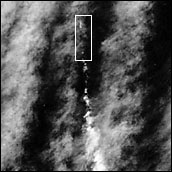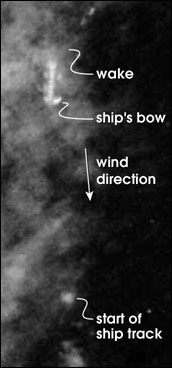Though these results suggested that sulfur dioxide from fossil fuels made the
clouds brighter, the scientific community was not the first group to take a
strong interest in the study. "The Pentagon saw the very first paper my
colleagues wrote and they ran a database search on their vessels in the Pacific.
They found that some of these ship tracks rose from their military ships, which
were trying to hide under clouds," said King. Coakley was asked to brief
the Chief of Naval Operations at the time.
Not long afterwards the scientific community began to focus on the results.
Many researchers believe this study could go a long way towards explaining the
temperature discrepancy between the Earth’s hemispheres. Since researchers
have been monitoring global warming, they have noticed a disturbing trend —
the Southern Hemisphere seems to be warming up faster than the Northern
Hemisphere. "The dominant hypothesis in the scientific community today is that
aerosol forming pollution is greater in the Northern Hemisphere than in the
Southern Hemisphere and this contributes a mitigating influence on global
warming expected from the greenhouse effect," said King.
He stated that the effects of the sulfur dioxide from industry might be
countering the greenhouse effect created by carbon dioxide, but only in the
Northern Hemisphere. When fossil fuels are burned, both carbon dioxide and
sulfur dioxide are released. As demonstrated in the ship tracks study, sulfate
particles produced from sulfur dioxide creates brighter clouds, which may cool
the atmosphere. Any light that is reflected cannot reach the ground and heat the
surface of the Earth. This means there is less heat for carbon dioxide and other
greenhouse gases to trap in the atmosphere.
The long-term effect of carbon dioxide and sulfur dioxide is not simply
dependent on the concentration of the gases released. Rather, the amount of time
the molecules spend in the atmosphere and their movement across the Earth plays
a bigger role. King explained that carbon dioxide stays in the air for years and
spreads out across the entire globe. Sulfur dioxide gets into the atmosphere and
is converted to sulfate particles that form both a layer of polluting haze and
brighter clouds. These particles dissolve and either settle back to the Earth
from the forces of gravity alone or through precipitation. Rarely do the
particles or the clouds they inhabit stay in the skies long enough to cross the
equator, King said
So the problems created by carbon dioxide are felt globally while the
"benefits" of the sulfur dioxide are felt locally. In the Northern
Hemisphere, where most pollution of the world has been created, aerosol-laden
clouds as well as layers of pollution could have stifled the effects of global
warming. Over the Southern Hemisphere, which hasn’t had a long history of
industrialization, carbon dioxide has built up unchecked. Consequently the
Southern Hemisphere has been warming up more quickly (King et al. 1995). |
|


This photograph from a NASA high-altitude research plane
shows a ship sailing towards the bottom of the photograph with a ship track blown
out ahead of it. The ship track begins about 1,400 m downwind of the ship. (Photograph courtesy
Dr. Michael King, NASA GSFC)
|
| |
"Our understanding of aerosols and cloud formation is primitive,"
said Coakley. "There may be a lot more to this story." Until
scientists hone their knowledge of cloud formation and get an estimate of the
percentage of aerosols released by humans, no one will know for certain what
causes the different rates of warming between the hemispheres. Researchers have
conducted many field experiments since these initial findings. They continue to
answer much about man made aerosols and cloud formation, but many more questions
go unanswered. No one knows, for example, just how many aerosols a given cloud
can hold or the number of aerosols needed to keep a cloud from losing its
contents.
Coakley warned that even if this aerosol theory of global warming is correct,
we should not increase our consumption of fossil fuels. In time their full
effects will catch up to the people in the Northern Hemisphere as well. Carbon
dioxide will continue to remain in the atmosphere. Sulfur dioxide, once
converted to sulfate particles, will keep falling to Earth. Sooner or later the
effects of the carbon dioxide will far outweigh those of the sulfur dioxide.
References
1. King, M.D., L.F. Radke, and P. V. Hobbs, 1993: Optical Properties of
Marine Stratocumulus Clouds Modified by Ships, Journal of Geophysical
Research, 98(D2), pp. 2729-2739.
2. King, M.D., S. Tsay, and S. Platnick, 1995: In Situ Observations of the
Indirect Effects of Aerosols on Clouds. Aerosol Forcing of Climate, ed.
by R. J. Charlson and J. Heintzenberg, John Wiley & Sons, New York, 228-246.
3. Radke, L. F., J. A. Coakley, Jr., and M.D. King, 1989: Direct and Remote
Sensing Observations of the Effects of Ships on Clouds, Science, 246, pp.
1146-1149.
 Seeing the Clouds Close-Up Seeing the Clouds Close-Up
|
|
From 1940 to 1990, meteorological records showed the Southern Hemisphere
warming faster than the Northen. One hypothesis for this difference is that higher aerosol levels in
the north caused clouds to reflect more energy away from the Earth's surface. In the 1990s, however,
the Northern Hemisphere warmed more rapidly than the Southern. Aerosols are almost certainly affecting
regional climates, but natural variability makes it hard to measure large-scale climate trends. (Graph
by Robert Simmon, based on data from the Climate Research Unit (CRU) of the University of East Anglia) |

